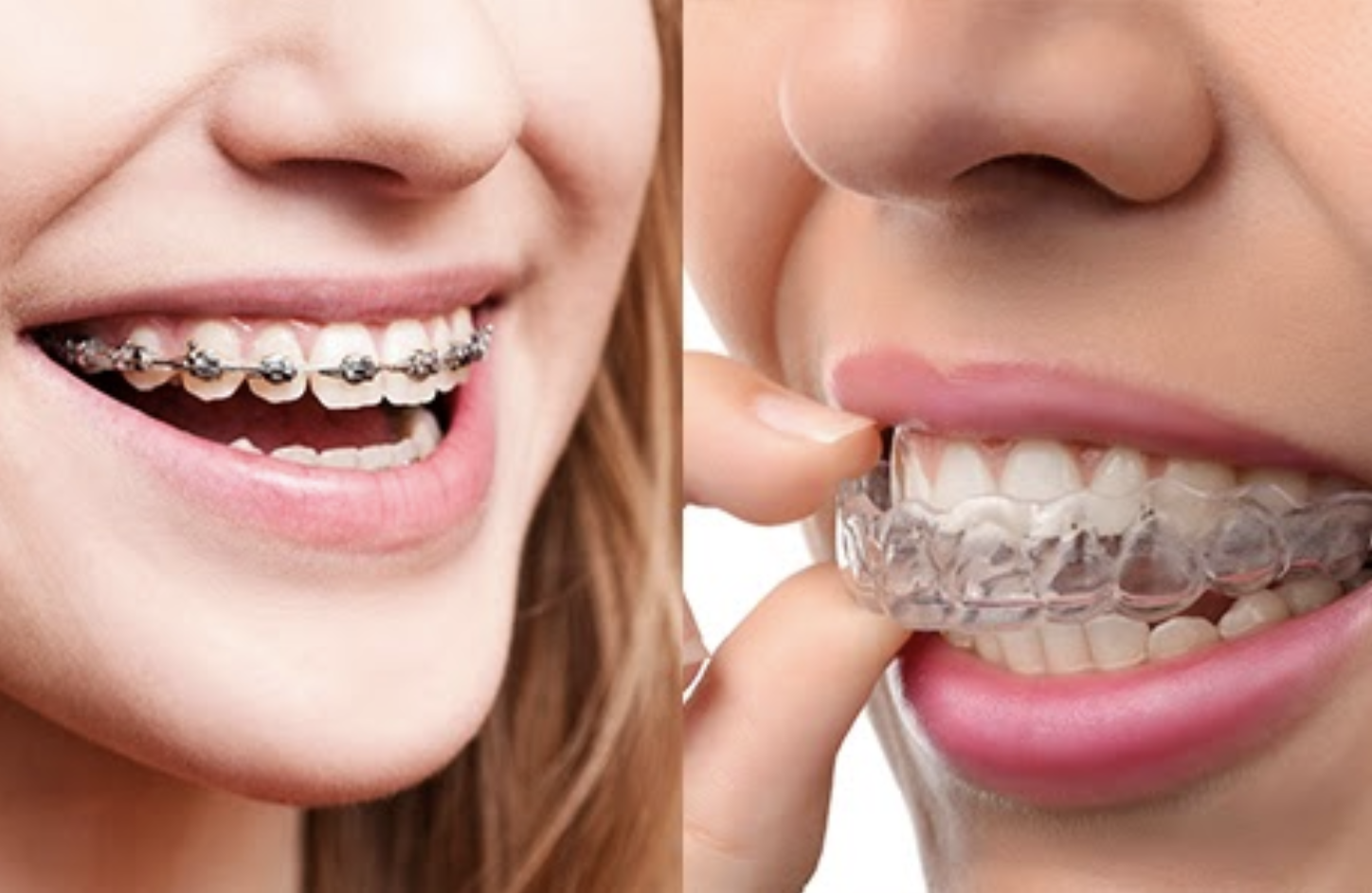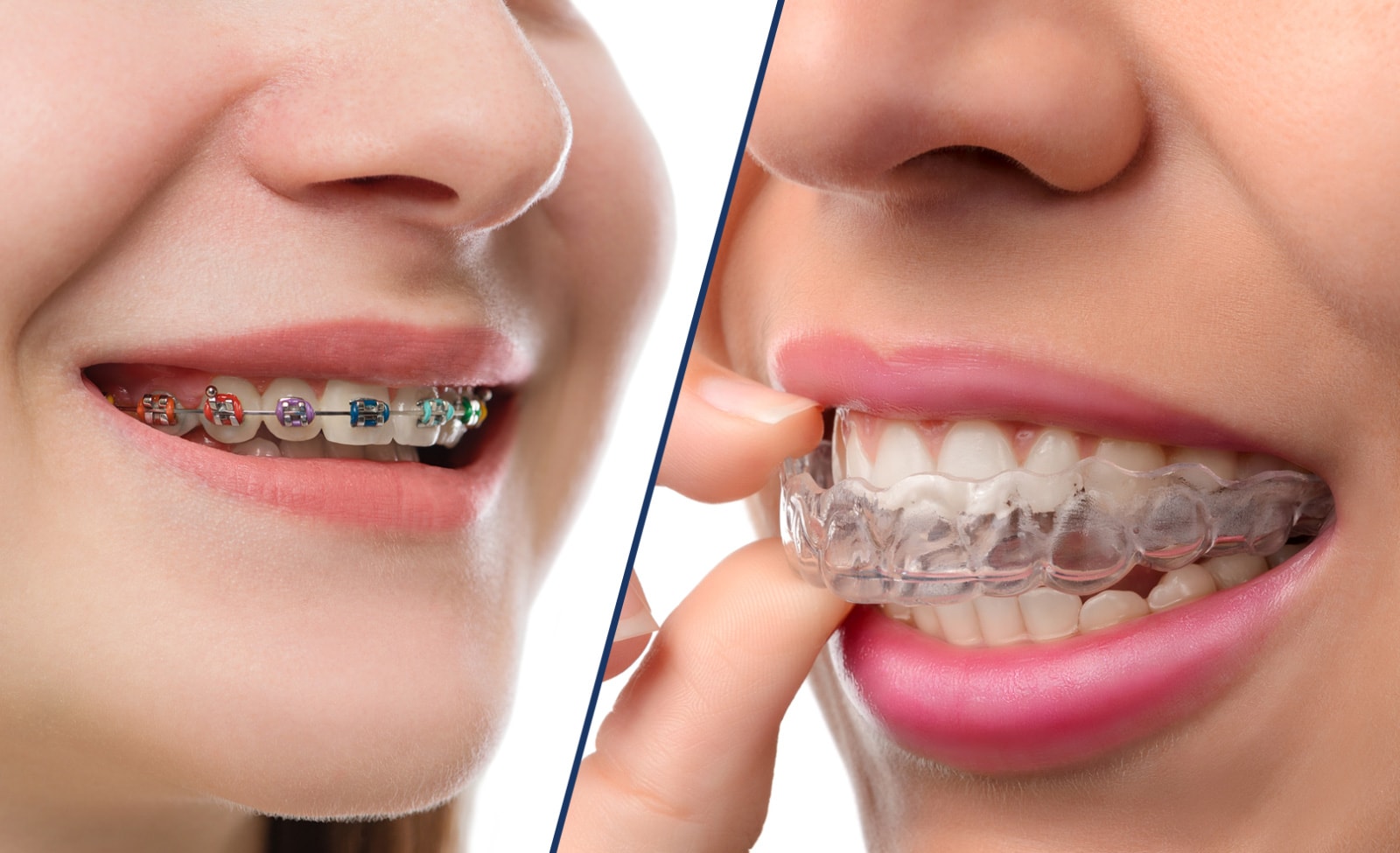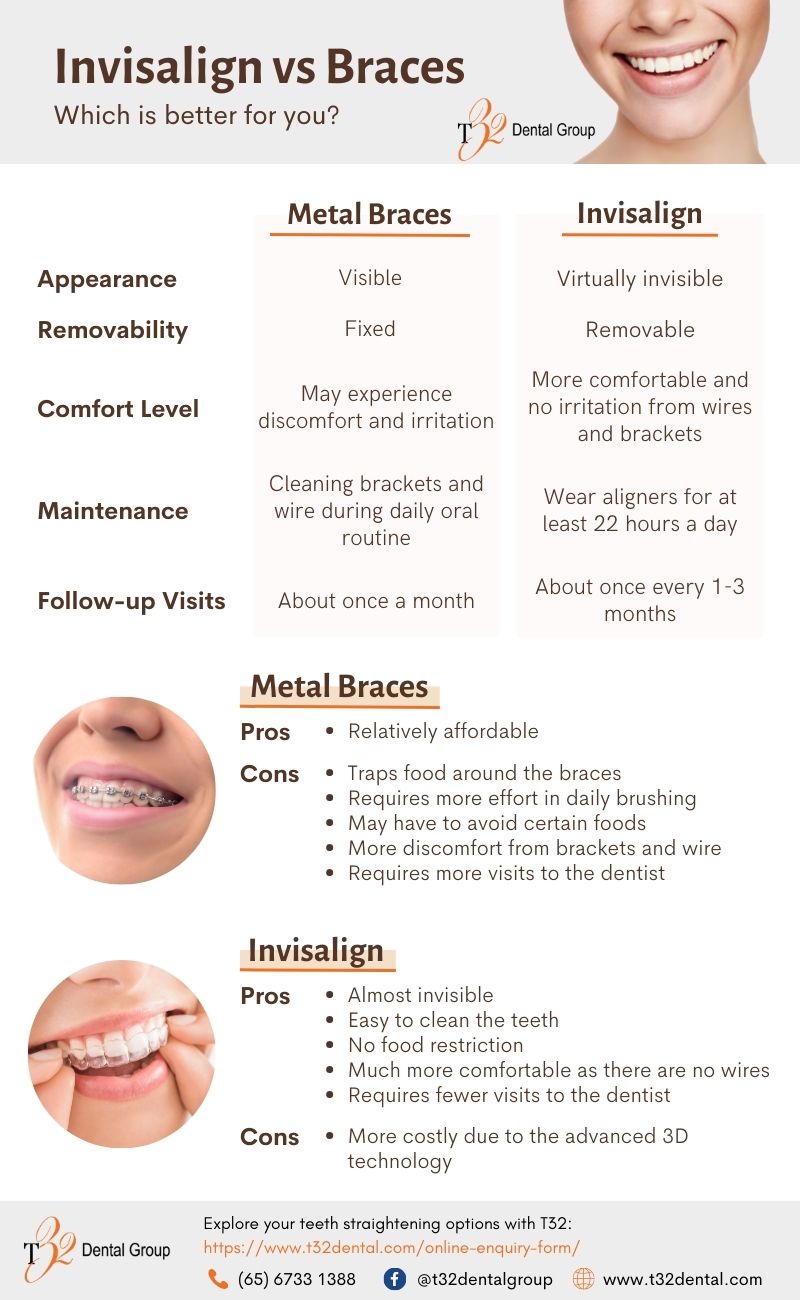Introduction to Invisalign and Braces
Orthodontic treatments have come a long way, with options now ranging from traditional braces to clear aligners like Invisalign. The goal remains the same: to create a healthy, normal bite and a beautiful smile. But the journey to that perfect smile can look very different depending on the treatment you choose.
Enter the World of Invisalign
Invisalign, a popular alternative to traditional braces, was launched in 2000. This innovative treatment uses clear aligners made from a patented SmartTrack material, praised for its comfort and effectiveness. The aligners are nearly invisible and fit snugly against your teeth, making them a discreet option for teeth straightening.
Invisalign treatment is a process of wearing a series of clear, removable aligners that gradually shift your teeth into their proper positions. Each set of aligners is slightly different, moving your teeth a little bit more every time you change to a new set.
Invisalign is offered by certified providers like Kristo Orthodontics and Great Northwest Dental, who have extensive experience in handling various orthodontic cases.
Traditional Braces: The Time-Tested Option
Braces, on the other hand, have been around for much longer. They are a form of orthodontic treatment that uses metal or ceramic brackets and wires to align your teeth and correct your bite. Braces are highly effective and can handle more complex orthodontic issues.
Orthodontic treatment with braces focuses on aligning teeth and achieving a proper bite. The pressure applied to the teeth gradually moves them into better positions.

This process involves regular orthodontic appointments, approximately every four to six weeks, to adjust the braces and monitor progress.
Orthodontic treatment, whether with braces or Invisalign, plays a vital role in smile design and function. It can address various bite problems, such as underbite, crossbite, overbite, open bite, crowding, and spacing.
Your Smile, Your Choice
Choosing between Invisalign and braces is a personal decision. It depends on your budget, lifestyle, and the complexity of your case. Both treatments have their pros and cons.
Invisalign offers flexibility and discretion, but it may not be suitable for severe misalignments or bite issues. Braces, while more noticeable, can handle more complex cases and are often less expensive.
Remember, investing in specialized orthodontic care is advisable for a perfect smile. Orthodontists offer safe and effective orthodontic care with the requisite education, training, and expertise.
If you’re considering Invisalign, consult with a certified provider like Kristo Orthodontics or Great Northwest Dental for a free consultation.
If you’re leaning towards traditional braces, make sure to consult with an orthodontist who can provide a personalized treatment plan based on a thorough examination.
Ultimately, the goal is to achieve a healthier, happier smile. So, take your time, do your research, and make an informed decision. Your smile is worth it!
Appearance and Comfort: Invisalign vs. Braces
When it comes to orthodontic treatments, the two most popular options are Invisalign and traditional braces. Both have their unique features, but what sets them apart in terms of appearance and comfort?
Appearance: The Invisible vs. The Noticeable
Invisalign, as the name suggests, is nearly invisible. The aligners are made from clear BPA-free plastic that is custom-moulded to your teeth. They blend in seamlessly with your smile, making them barely noticeable. This makes Invisalign a great choice for those who value discretion, such as business professionals or teenagers who might feel self-conscious about wearing traditional braces.
On the other hand, traditional braces are more noticeable. They consist of metal or ceramic brackets and wires attached to your teeth. While they are highly effective, they are also more visible. However, some people see this as a badge of honor, a visible sign of their journey to a perfect smile.
Comfort: The Smooth vs. The Sharp
In terms of comfort, Invisalign aligners are made of smooth thermoplastic, which provides a more comfortable experience compared to traditional braces. The aligners are changed every one to two weeks, and while some discomfort may be experienced in the first few days of wearing a new set, this usually subsides quickly.
Braces, on the other hand, can cause initial discomfort due to the pressure they put on your teeth and gums. The wires and brackets can also cause irritation in your mouth. However, this discomfort usually lasts only for a week and can be managed with over-the-counter pain relievers and orthodontic wax.
Impact on Daily Life: The Flexible vs. The Fixed
Invisalign aligners are removable, which means you can take them out when you eat or brush your teeth.

This allows you to maintain a healthy diet and good oral hygiene without any restrictions. It also means you can occasionally remove them for special occasions, making Invisalign a flexible option that can easily fit into your lifestyle.
Braces, however, are fixed to your teeth and can’t be removed. This means you’ll need to modify your diet to avoid foods that could damage the braces. Oral hygiene also becomes more challenging, as food can get stuck around the wires and brackets.
Choosing the Right Option for You
Choosing between Invisalign and braces is a personal decision. It depends on your lifestyle, your aesthetic preferences, and the complexity of your orthodontic issues. Both treatments have their pros and cons, and it’s important to consult with a professional to determine which is the right fit for you.
If you’re considering Invisalign, you can consult with certified providers like Kristo Orthodontics or Great Northwest Dental. They can provide a free consultation and help you understand if Invisalign is the right choice for you.
If you’re leaning towards traditional braces, make sure to consult with an orthodontist who can provide a personalized treatment plan based on a thorough examination.
Remember, the goal is not just to achieve a beautiful smile, but also to ensure the health and functionality of your teeth. So take your time, do your research, and make an informed decision. Your smile is worth it!
Treatment Duration and Maintenance
When it comes to orthodontic treatment, time is of the essence. You’re probably wondering, “How long will I need to wear these?” Let’s dive into the treatment duration for both Invisalign and braces.
Invisalign: The Quick Fix
Invisalign is known for its speed. For adults, treatment typically lasts 12-18 months. However, you’ll start seeing results in just a few weeks. Isn’t that exciting? But remember, it’s not a race. Each aligner should be worn for 20-22 hours a day and changed every week or two. This ensures your teeth move gradually and safely.
Invisalign can correct mild to moderate misalignments and even some severe cases. But, the treatment time can vary based on factors like crowded teeth or gaps. Teenagers might need a bit more time due to compliance issues. But don’t worry, special aligner trays with compliance indicators are available for them.
Braces: The Steady Journey
Braces, on the other hand, require a bit more patience. The shortest treatment time is usually 12-24 months. But remember, every smile is unique. The treatment time can vary based on your dental needs. Adults might need slightly longer due to the complexity of moving adult teeth into position. But, with different types of braces like metal and ceramic, you can achieve quicker results.

Just like with Invisalign, compliance with your orthodontist’s instructions is crucial for smooth progress. And yes, retainers are necessary after braces are removed to prevent teeth from moving back.
Maintenance: The Key to Success
Now, let’s talk about maintenance. For Invisalign, proper care is essential. Aligners should be removed for eating, drinking (except water), and cleaning teeth. Regular cleaning with a soft-bristled toothbrush and rinsing after removal is a must.
After your Invisalign treatment, you’ll need to wear a retainer to maintain alignment. Greeley Dental Care offers Invisalign treatment and can guide you through the maintenance stage.
For braces, oral hygiene is a bit more challenging. You’ll need to brush your teeth after every meal, use specific flossing products, and avoid sticky, chewy, or hard foods. HealthHub Singapore provides excellent tips for oral care with braces.
Remember, whether you choose Invisalign or braces, the journey to a perfect smile requires time, patience, and proper care. But trust me, the results are worth it. Your smile is your best accessory, so wear it with pride!
Effectiveness and Corrective Capabilities
When it comes to orthodontic treatment, effectiveness is key. Let’s delve into the corrective capabilities of Invisalign and braces.
Invisalign: The Clear Choice
Invisalign, a treatment that uses clear plastic aligners, is known for its effectiveness. Research shows that Invisalign is as effective as traditional braces and may even offer shorter treatment times. This makes it a popular choice for those seeking a quick fix.
Invisalign can address a range of orthodontic issues. From overbites and underbites to crossbites and gaps between teeth, Invisalign has you covered. However, it’s not a one-size-fits-all solution. Certain tooth issues, like short, round, or pegged teeth, may not respond well to Invisalign. Similarly, if your molars need to rotate more than 20 degrees or tilt more than 45 degrees, Invisalign might struggle.
Braces: The Traditional Route
Braces, on the other hand, are a tried-and-true method. They’ve been around for decades and have proven their effectiveness time and time again. From mild to severe cases, braces can tackle it all.
However, braces come with their own set of challenges. They can cause discomfort and make oral hygiene practices more difficult. But don’t let this deter you. With careful maintenance and a bit of patience, braces can transform your smile.
Choosing the Right Treatment
So, how do you choose between Invisalign and braces? It’s not a decision to be taken lightly. Consider your lifestyle, appearance preferences, and treatment time.

Consult with an orthodontic specialist to determine the best treatment option for you. Companies like Impress offer orthodontic treatment with fewer in-person visits and fixed prices.
Remember, both Invisalign and braces have their advantages. Invisalign offers more flexibility and is less invasive. Braces, while more noticeable, can handle more complex cases.
Embrace the Journey
Orthodontic treatment is a journey, not a race. Whether you choose Invisalign or braces, remember to follow your orthodontist’s instructions carefully. Proper care and maintenance are crucial for success.
Your smile is your best accessory. So, take the time to invest in it. With the right treatment, you can achieve a smile that not only looks great but also boosts your confidence. After all, a confident smile is the best kind.
In the end, the choice between Invisalign and braces is a personal one. But rest assured, both options can lead you to the smile of your dreams. So, take the leap and embark on your orthodontic journey. You won’t regret it.
